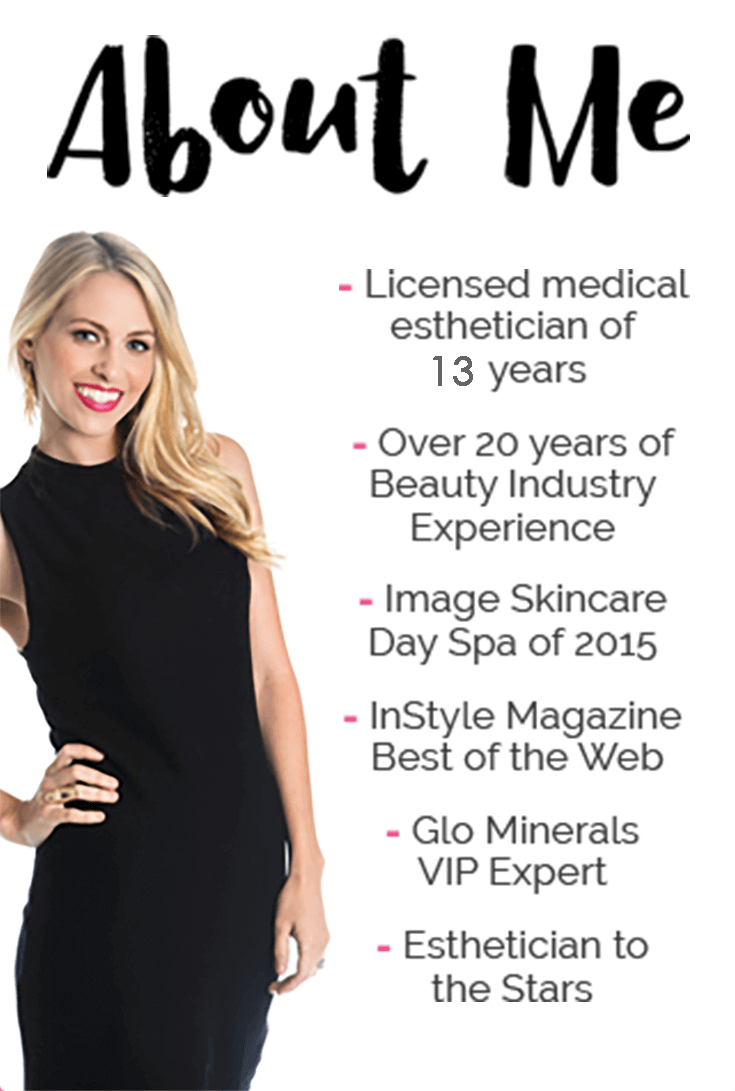What Should You Be Using In Your Skin Care Routine?
Take my quiz and get personalized recommendations from a
licensed esthetician!
Surprising Toxic Commonly Used Sunscreens & What Are the Risks?
We’re right in the middle of "June gloom" here in Southern California . But, soon the cloud cover will burn off and the sun will shine, ushering one of my favorite times of the year.
As a skincare professional, sunscreen is a daily part of my life (yes, even on overcast days). And with summer weather comes more time in the sun, so we have to make sure our protection is on point!
 With a husband who surfs, and has a family history of skin cancer, I’m always lovingly reminding him to slather on the SPF before heading to the beach. And with two beach babies, I have to make sure their skin is protected so we don’t have to nurse any sunburns.
With a husband who surfs, and has a family history of skin cancer, I’m always lovingly reminding him to slather on the SPF before heading to the beach. And with two beach babies, I have to make sure their skin is protected so we don’t have to nurse any sunburns.
But, sunscreen isn’t just an item we should add to our summer beauty regimen. We should take steps to make sure we’re keeping our skin beautiful and protected from the sun year round.
Esthetician Tip: A good rule of thumb for just about any SPF lotion is to reapply it every hour.
The harsh reality is that many of us aren’t even using sunscreen, (I'm looking at you, gentlemen!). A 2013 survey by the Centers for Disease Control found that an alarming percentage of the men and women surveyed (gasp!) don’t wear sunscreen at all.
These numbers are shockingly low considering that cases of melanoma are on the rise each year.

Alright, now that I’ve no doubt effectively convinced you about the importance of wearing sunscreen, you’re probably wondering,
Yeah, but aren’t there chemicals in sunscreen that are considered toxic?
The honest answer is this: with all the reports swirling around these days, it’s hard to know what to think about sunblock.
Today, we’re going to look at some of these controversial chemicals to see if we can find out what role they play in preventing sun damage, and what potential risks they pose to users.
Types of Sunscreen Filters
Sunscreen UV filters are broken down into two different categories of active ingredients: chemical and physical.

Physical Sunscreens
Physical sunscreens use zinc oxide and titanium dioxide as active ingredients to physically cover the skin’s surface. They block and reflect UV rays and protect against sun damage caused by UVA and UVB rays.
Some people with sensitive skin prefer physical sunscreens, since they cause less irritation and pose lower risks for allergic reactions.
When you think of zinc and titanium sunblock, you might be picturing lifeguards with white noses. But today’s physical sunscreens are super lightweight and wearable without any of that white residue.
My Favorite Physical Sunscreens

Eminence Organics Sun Defense Minerals
This mineral sunscreen totes an SPF 32 protection and is the perfect product for those who typically skip reapplication for fear of it messing with their makeup. Simply brush this over makeup for a beautiful, refreshed look!

Epicuren’s Zinc Oxide Perfecting Sunscreen SPF 27
A wonderful physical sunscreen option and very friendly for all skin types (including acneic). This gentle sunscreen protects and hydrates while reducing the appearance of dark spots and evening your skin tone.

Glo Minerals Tinted Primer SPF 30
This amazing NEW product allows you to tint, prime, and protect your skin. This formula goes on nice and matte, making it an especially wonderful option for oily/combo skin types. It can be worn as a primer, under foundation, or on its own!
Chemical Sunscreens
Chemical sunscreens include barriers that filter and absorb UV radiation. Some of these ingredients are absorbed into the skin. While absorption can offer effective protection to deep skin layers, the fact that they are absorbed can cause some users to experience adverse skin reactions.
These types of sunscreens are more common and can include any or all of the most common chemical ingredients.
My Top Picks

Image Skincare’s Prevention+ Daily Ultimate Protection Moisturizer SPF 50
A blend of physical and chemical protectors, this moisturizer is a great option for those seeking sun protection plus anti-aging benefits, as its formula includes antioxidants and plant stem cells.

COOLA Sport SPF 50 Guava Mango Sunscreen Spray
This spray is a wonderful option for quick, easy, and lightweight body protection. It contains 70% certified organic ingredients. And, an added bonus: it smells amazing!
6 Common Chemical Sunscreen Compounds
Let’s dive in and take a look at some of the most commonly found chemical ingredients in sunscreen and some of the health concerns associated with them.
 Oxybenzone
Oxybenzone
Function: A synthetic form of estrogen, this is a penetration enhancer, meaning, it helps chemicals penetrate the skin.
Safety Concerns
- A study by the CDC determined that “97% of Americans are contaminated with....oxybenzone that has been linked to allergies, hormone disruption and cell damage.” This is due, in large part, to the chemical’s ability to penetrate skin.
- It has been linked to allergic reactions in users. One study found that 1 in 5 test patients developed allergic reactions to photopatch tests when exposed to oxybenzone.
- It can cause cell damage which results when oxybenzone is exposed to sunlight causing it to form free radicals.
- Oxybenzone has been identified as a hormone disruptor which can alter the endocrine system.
Retinyl Palmitate
Function: A form of Vitamin A, it is used as an antioxidant to help slow the aging effects of UV exposure.
Safety Concerns
- While it has been suggested that retinyl palmitate can produce free radicals that lead to mutated skin cells, there’s insufficient research to confirm this. Dermatologists land on both sides of the line either advocating its use or encouraging sunscreen users to avoid it completely.
 Octisalate
Octisalate
Function: Absorbs UVB rays and works to stabilize avebenzone (another UV-absorbing chemical) for longer lasting protection.
Safety Concerns
- This ingredient’s ability to penetrate skin can cause irritation in some users..
 Octocrylene
Octocrylene
Function: Gets absorbed into skin and sucks up UV rays.
Safety Concerns
- After this ingredient is absorbed into skin, it could produce free radicals which have the potential to damage cells..
 Homosalate
Homosalate
Function: Absorbs UV light, specifically UVB rays.
Safety Concerns
- Possible impact on hormone system, specifically estrogen.
- Could contaminate breast milk of nursing mothers after being absorbed into the skin. One study found the presence of UV filters in breast milk in 85.2% of the mother and child pairs tested.
 Octinoxate
Octinoxate
Function: Filters UVB rays and protects against sunburn.
Safety Concerns
- Possible estrogen and hormone disruption.
If these chemicals carry so many potential risks, why are they in sunscreen at all?
Because they effectively filter or absorb harmful UV rays to protect your skin from the risks of sun damage and skin cancer.

More research is needed about the true impact of these ingredients on the human body. In many tests, data was gathered when subjects were exposed to large amounts of the chemicals over a longer period of time.
Some experts argue that, when you use sunscreen, you’re being exposed to smaller amounts of these chemicals, so their impact may not be as severe.
So what’s the solution?
You have to consider the risks and benefits of using sunscreen. Even though there are concerns about the ingredients, the risk of potentially getting skin cancer if you don’t use sunscreen far outweighs the risks of using it.
If you have specific health concerns or questions, don’t be afraid to book an appointment and talk to a doctor or dermatologist.
Ultimately, the solution is to take care of your fabulous self and practice responsible skincare when it comes to sun exposure. This includes finding the right sunscreen, being diligent about applying and reapplying your sunscreen, and taking measures to stay out of direct sunlight.
My Favorite Suncare Tips
- Apply liberally - Most people spread on a light layer of sunscreen, but experts recommend a shot glass full as the amount you should be using. That’s right, slather on that protective goodness to your all-overness. And remember to apply 15-30 minutes before sun exposure for optimum protection.

- Reapply - One of the most common mistakes that results in sun damage is forgetting to reapply. It can be hard to remember when you’re having fun in the sun, but make sure to refresh your protection every 2 hours if you’re in indirect sunlight, and every 1 hour if you’re in direct light.
- Know Your SPF - A higher SPF number doesn’t equal longer sun exposure time. The SPF number indicates the percentage of UV rays that are blocked. Consult your sunscreen’s approximate maximum protection time and don’t exceed it.

- Seek Cover - Your best defense against sun damage is to cover up. Take a break in the shade, rock your wide brimmed hat, or invest in some light and comfy SPF clothing.
Conclusion
No matter which type of sunblock you decide is right for you, make sure you’re taking care of your skin every day. Especially if you’re going to be out enjoying that lovely summer sun!
What are some of your favorite ways to protect your skin from the sun? Tell me in the comments below!
Top Brands
New Brands

Recent Posts

Are You Taking the Right Steps to Care for Your Skin?
Take the Quiz
Skincare Secrets!
10-step guide for healthy, beautiful skin after kids.
100% privacy. I will never spam you!














